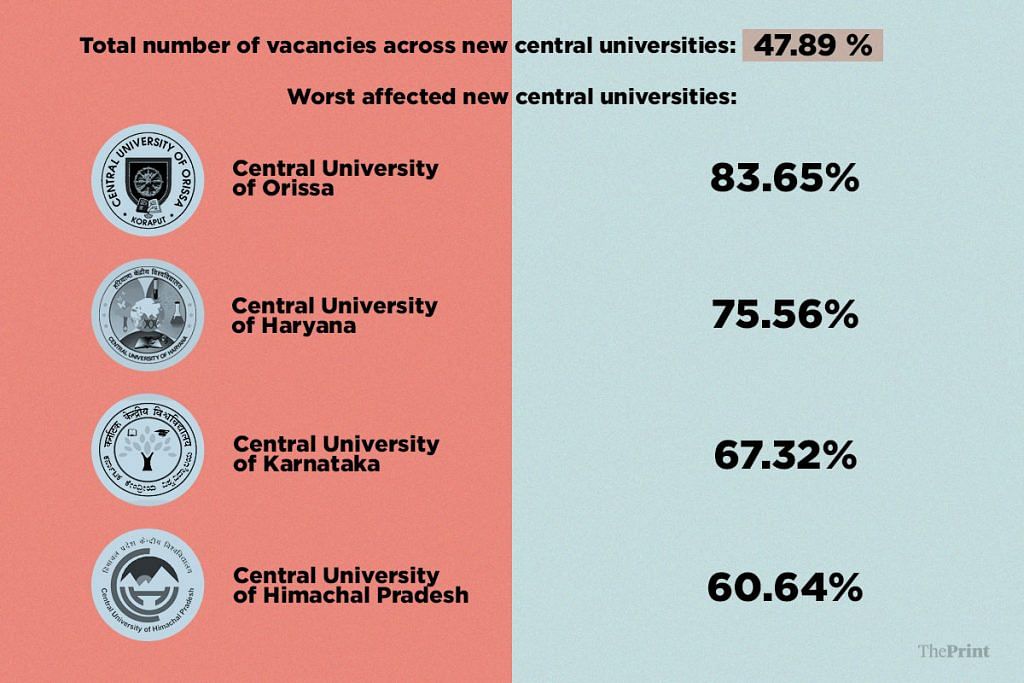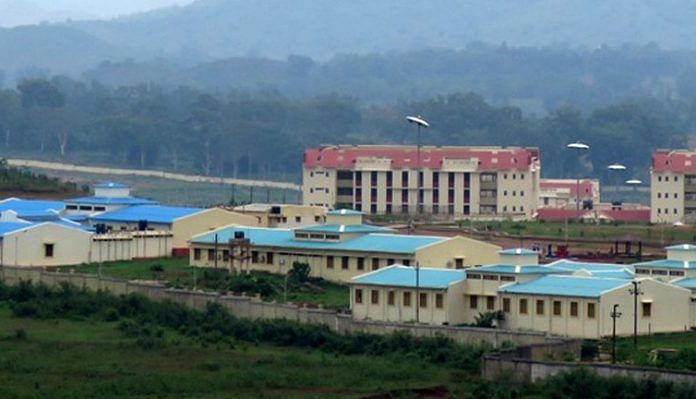Central University of Orissa is running with just 16 per cent of permanent faculty, those in Himachal Pradesh and Karnataka have more than 60 per cent vacancies.
New Delhi: India’s central universities are struggling with vacancies as more than a third of teaching positions have not been filled. But this problem has not even spared the new central universities that were set up with much promise in the past one decade, ThePrint has found.
After 2009, a number of universities were opened in Haryana, Gujarat, Odisha, Rajasthan, Tamil Nadu, Jammu and Kashmir and Bihar. However, of late many of them are grappling with issues such as faculty shortage and infrastructure.
The Central University of Orissa, for instance, is running with just 16 per cent of permanent faculty, according to information accessed through RTI Act by ThePrint.
Similarly, 75 per cent of teaching positions are vacant at the Central University of Haryana. Even those in Himachal Pradesh and Karnataka have more than 60 per cent vacancies.
“We had already advertised for the posts and the process of filling up vacancies was almost done but it had to be put on hold,” a senior official at Haryana Central University told ThePrint.
“We cannot appoint new teachers because of the ongoing court case with regard to the UGC’s circular on hiring reserved category candidates,” the official added.

Acute shortage of faculty
With 83.65 per cent of faculty shortage, the Central University of Orissa has the highest number of vacancies among the new central universities. The reason behind this, the administration says, is “uncalculated moves” in the past.
“The large number of permanent vacancies that you see in the university is because of some uncalculated decisions in the past,” vice-chancellor Sachidananda Mohanty told ThePrint.
“Departments were opened without hiring any faculty members. So now, I am not opening any new departments until the time I am able to hire faculty members,” he said.
He too admitted that the UGC circular had put a dampener in the hiring process.
The Central University of Karnataka is functioning with less than 40 per cent of permanent faculty members. “Ever since the university became functional, we have had faculty vacancies. However, the number of vacancies for permanent posts has gone too high and we are working on it,” said Chandrakant M. Yatanoor, registrar of the university.
“The 5 March UGC order changed the reservation counting system and we were asked to wait as the matter is in court now,” he added.
Yatanoor claims the university is managing with guest faculty in the absence of permanent ones, hiring them on a one-year contract with a salary of Rs 40,000 for non-PhDs and Rs 45,000 for PhD holders.
Infrastructure hurdles
Another reason for the delay in filling up the vacant positions is the location of these universities. The Mahatma Gandhi Central University in Motihari, Bihar, for example, did not have landline phones due to its remote location, sources pointed out.
“Location of the university is a problem, which is why we have a problem in getting faculty members. Who would want to come to such a remote location with their family?” vice-chancellor of the university Arvind Agrawal had reportedly pointed out during a meeting with President Ramnath Kovind.
President Kovind, who is Visitor for all central universities, had in January this year held a meeting of VCs of all 17 new central universities during which he had asked them to expedite the process of filling up faculty positions. Another major issue highlighted by the VCs was infrastructure.
Of the 17 varsities, only five — Karnataka, Rajasthan, Haryana, Kerala and Tamil Nadu — have moved to permanent buildings.
Four central universities — one each in Gujarat, Himachal Pradesh, Bihar and J&K — haven’t even been allotted land by the respective state governments to build their campuses.
The Central University of Kashmir, for example, has been struggling to get a decent plot of land. The one that was allotted to the varsity is marshy.
“We have been struggling to get land from the state government for years now, but there is no land available in Srinagar,” said a senior official from the university.
“Despite being a central university, we have been functioning from a temporary campus,” the official said.
In the 11th Five Year Plan, the then UPA government had approved the plan of setting up of one central university in each state, which did not have one until then. Accordingly, 16 varsities were established by the Central Universities Act, 2009 in different states.




There is one way to reduce the gap. Retired IAS, IPS, IFS and scientists from DRDO, Space, Atomic Energy etc with rich experience but not acquired PhD should be considered if they apply against vacancy. UGC and AICTE should relax these norms.
Acche Din!